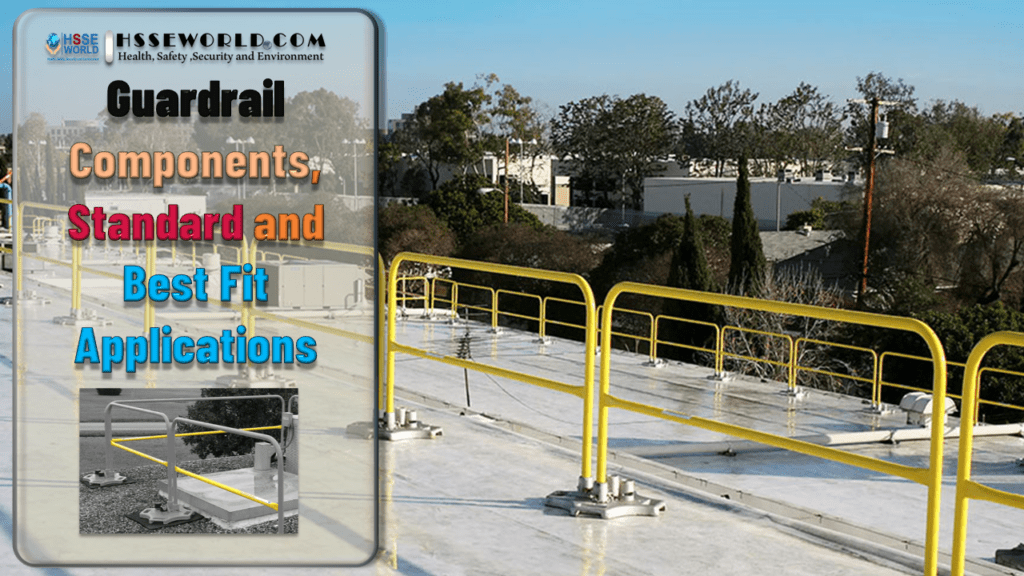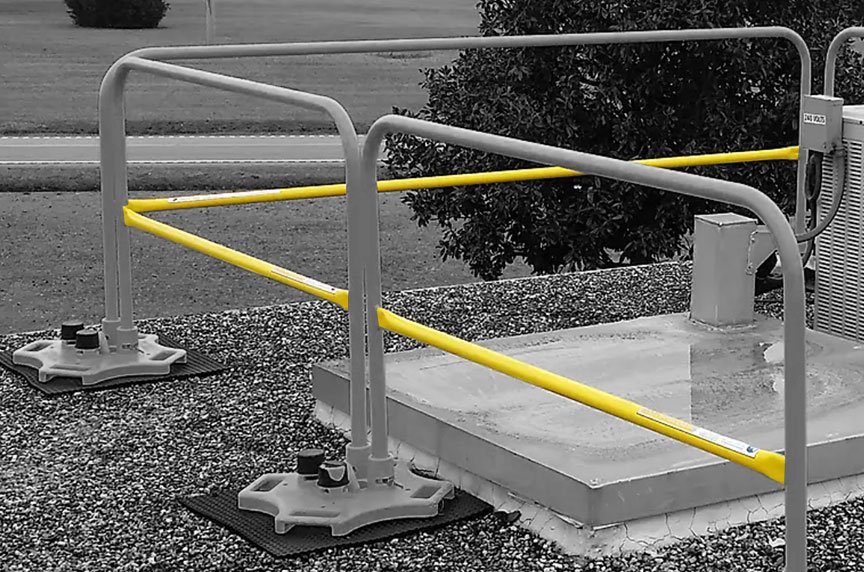Guardrail Components, Standard and Best Fit Applications
6 min readThe goal for every employee working at height is to make it home safely at the end of every shift. Guardrails are a stationary (or “fixed”) system used to protect workers from falls when working at heights. Guardrails are a preferred means of protecting workers because the system does not rely on the worker to be trained to use, inspect, and wear a fall protection system.
Well-built guardrails are a reliable and convenient means of fall protection because they act as a visible and physical barrier to help prevent falls from heights or between levels including falls from roofs, balconies, stairwells or falls into open holes. Guardrails are used where covers, floors, or walls cannot be installed or are not practical.
In this article, we will look at the following:
- Definition of a guardrail
- Reasons for fall prevention systems
- Standards of governance for guardrails
- Dos and don’ts of guardrail usage
- Best-fit applications
- Bad-fit applications

Why Is It Necessary to Have Fall Prevention Measures?
According to OSHA (Occupational Safety and Health Administration) Publication 2056, there are nearly 6,000 workplace fatalities in the United States and 50,000 deaths due to workplace-related illnesses each year. Also, there are 5.7 million non-fatal workplace injuries, which cost U.S. businesses over $125 billion annually.
Falls are the leading cause of death in the construction industry, and most fatalities happen when employees fall from open-sided floors and through floor openings. Falls from as little as 4’ to 6’ can cause long-term time away from work, and in the most severe cases, death, which means all open-sided floors and platforms 6’ or more in height must be guarded.
What Is A Guardrail?
Guardrails serve as passive fall protection in the Hierarchy of Fall Protection. The standard guardrail system features a top rail, intermediate (or mid) rail, and support posts.
Guardrails are used in every industry and can be seen in:
- retail shops
- industrial settings
- construction sites
- warehouses
- shipping facilities
- landscaping and work areas in natural settings, and
- any workplace with an accessible rooftop.
Also Read: What is the difference between fall protection and fall prevention
To add more layers of protection, screens, mesh, or balusters could be utilized in tandem with the guardrails.
Guardrails need to have a minimum breaking strength of 200 lbs. in any direction per OSHA 1910.29(b)(3)(4)(5). A guardrail consists of a top rail 42” + or – 3” no less than 39”, mid-rail at 21” and toe board 3.5” high. Guardrails should be inspected per the manufacturer’s specifications or a qualified person’s requirements.
Midrails are halfway between the top rail and walking/working surface and must stand up against a downward and outward directional force of at least 150 lbs.
If wire-rope guardrail systems are utilized, highly visible tape or flags must be placed every 6’ to increase visibility.
Toe boards shall be provided when employees below could be exposed to falling objects such as tools. Toe boards shall be at least 3.5” (8.9 cm) in height from top edge to floor level, and be capable of withstanding a force of 50 lbs. (222 N) applied in any direction.
What Are the OSHA Specifications for Guardrails?
Guardrail requirements are listed in the OSHA 1926.451(g)(4) standard.
In this standard, OSHA says: “Guardrail systems shall be installed along all open sides and ends of platforms. Guardrail systems shall be installed before the scaffold is released for use by employees other than erection/dismantling crews.
“The top edge height of toprails or equivalent member on supported scaffolds manufactured or placed in service after January 1, 2000, shall be installed between 38” (0.97 m) and 45” (1.2 m) above the platform surface. The top edge height on supported scaffolds manufactured and placed in service before January 1, 2000, and on all suspended scaffolds where both a guardrail and a personal fall arrest system are required shall be between 36” (0.9 m) and 45” (1.2 m). When conditions warrant, the height of the top edge may exceed the 45” height, provided the guardrail system meets all other criteria of paragraph (g)(4).”
“Shall” is defined as mandatory, according to OSHA 1926.32(q).
When midrails, screens, mesh, intermediate vertical members, solid panels, or equivalent structural members are used, they shall be installed between the top edge of the guardrail system and the scaffold platform.
When midrails are used, they shall be installed at a height approximately midway between the top edge of the guardrail system and the platform surface. When screens and mesh are used, they shall extend from the top edge of the guardrail system to the scaffold platform, and along with the entire opening between the supports.
Safety Program for Working at Heights
Do’s and Don’ts For Guardrails
OSHA states that guardrails shall be surfaced to prevent injury to an employee from punctures or lacerations and to prevent snagging of clothing.
According to the standard, steel or plastic banding shouldn’t be used as a toprail or midrail. Also, manila or plastic (or other synthetic rope) being used for toprails or midrails shall be inspected by a competent person as frequently as necessary to ensure that it continues to meet the strength requirements of a minimum 200 lb. capacity.
Cross-bracing is acceptable in place of a midrail when the crossing point of two braces is between 20” and 30” above the work platform or as a toprail when the crossing point of two braces is between 38” and 48” above the work platform. The end points at each upright shall be no more than 48” apart.
What Are Best-Fit Applications for Guardrails?
Scaffolds
Guardrails are commonly used for walkways/working areas inside factories, and they are important components of scaffold platforms.

For adequate fall protection, while using scaffolds 10’ or more above a lower level working surface, workers must be protected with a personal fall arrest system or guardrail system.
Depending on the type of scaffold being utilized, a guardrail system AND personal fall arrest system may be required.
On scaffolding, guardrails are mandated to be installed along all open ends and sides of the platform before the systems are fit for use.
Like other fixed guardrails, workers on scaffolds must be protected by a toprail, midrail and toe board to prevent objects that are kicked off the deck from falling down and injuring workers on lower levels of projects.
Ladders
When exiting the top of the ladder to climb onto a surface, such as a roof, do you have unguarded edges?
If the answer to that question is yes, fall protection must be maintained. Guardrails or a personal fall arrest system would be your best option.
Also Read : Photo of the day: 10 Scaffold Safety Essentials
What Are Bad-Fit Applications for Guardrails?
Scissor Lifts
Scissor lifts are considered mobile scaffolds, and you may be required to wear a personal fall restraint system. However, it is important to remember to connect to the manufacturer’s designed anchorage point. You never want to use a guardrail as an anchor point.
Aerial Work Platforms
Also known as boom lifts or articulating boom lifts, aerial work platforms support workers on an elevated surface. Aerial work platforms allow employees to work freely with both hands and prevent falls, but you always want to wear a full-body harness while in use.
The full-body harness must be attached with a lanyard to the manufacturer’s designed anchor points.
Suspended Scaffold Systems
If you’re working on a suspended scaffold system, like window washers, having vertical lifelines fixed to the roof or another structural surface would be the preferable option.
Note: It is important to remember guardrail systems are designed and installed to adhere to ASME and OSHA safety standards. Guardrails are designed and built to specific safety regulations and should not be modified in any way. If there is damage to a guardrail, the fall prevention system must be repaired promptly. Also, guardrails should not be used as an anchor point for fall protection systems, Should a guardrail section be removed for the delivery of materials, fall protection systems need to be in place.
Please visit our Safety Resources SAFETY BAG to have many Safety Resources




